A Comprehensive Phytochemical Analysis of Terpenes, Polyphenols and Cannabinoids, and Micromorphological Characterization of 9 Commercial Varieties of Cannabis sativa L.
Abstract
:1. Introduction
2. Results and Discussion
2.1. Analysis of the Volatile Fraction
2.1.1. Analysis of EOs Yields
2.1.2. GC-FID Quantitative Determination of Hemp EO Main Constituents
2.1.3. GC-MS Analysis of EOs
2.1.4. Chiral GC-MS Analysis of EOs
2.1.5. SPME-GC-MS Analysis of Untreated Material
2.2. Spectrophotometric Analysis of Lyophilized Extract and Deterpenated Material
2.3. 1H-NMR Analysis of UM and DM
2.4. HPLC-DAD-MSn Analysis of LE, DM and UM
2.5. Multivariate Statistical Analysis of EOs and UM
2.6. Micromorphological Analysis
3. Materials and Methods
3.1. Origin of the Commercial Varieties
3.2. Growing and Harvesting Conditions
3.3. Hydrodistillation
3.4. Analysis of the Volatile Fraction
3.4.1. GC-FID Analysis of EOs
3.4.2. GC-MS Analysis of EOs
3.4.3. Chiral GC-MS Analysis of EOs
3.4.4. SPME-GC-MS Analysis of UM
3.5. Spectrophotometric Analysis of LE and DM
3.5.1. Samples Treatment
3.5.2. Total Polyphenols Content
3.5.3. Total Flavonoids Content
3.5.4. Radical Scavenging Activity
3.6. 1H-NMR Analysis of UM and DM
3.7. HPLC-DAD-MSn Analysis of LE, DM and UM
3.8. Multivariate Statistical Analysis of EOs and UM
3.9. Micromorphological Analysis
3.9.1. Light Microscopy (LM)
3.9.2. Scanning Electron Microscopy (SEM)
4. Conclusions
Author Contributions
Funding
Institutional Review Board Statement
Informed Consent Statement
Data Availability Statement
Acknowledgments
Conflicts of Interest
References
- Pacifici, R.; Pichini, S.; Pellegrini, M.; Tittarelli, R.; Pantano, F.; Mannocchi, G.; Rotolo, M.C.; Busardò, F.P. Determination of cannabinoids in oral fluid and urine of “light cannabis” consumers: A pilot study. Clin. Chem. Lab. Med. 2019, 57, 238–243. [Google Scholar] [CrossRef] [PubMed]
- Mnekin, L.; Ripoll, L. Topical Use of Cannabis sativa L. Biochemicals. Cosmetics 2021, 8, 85. [Google Scholar] [CrossRef]
- Nabbout, R.; Thiele, E.A. The role of cannabinoids in epilepsy treatment: A critical review of efficacy results from clinical trials. Epileptic Disord. 2020, 22, S23–S28. [Google Scholar] [CrossRef]
- Nelson, K.M.; Bisson, J.; Singh, G.; Graham, J.G.; Chen, S.N.; Friesen, J.B.; Dahlin, J.L.; Niemitz, M.; Walters, M.A.; Pauli, G.F. The essential medicinal chemistry of cannabidiol (CBD). J. Med. Chem. 2020, 63, 12137–12155. [Google Scholar] [CrossRef] [PubMed]
- Bertoli, A.; Tozzi, S.; Pistelli, L.; Angelini, L.G. Fibre hemp inflorescences: From crop-residues to essential oil production. Ind. Crops Prod. 2010, 32, 329–337. [Google Scholar] [CrossRef]
- Happyana, N.; Agnolet, S.; Muntendam, R.; Van Dam, A.; Schneider, B.; Kayser, O. Analysis of cannabinoids in laser-microdissected trichomes of medicinal Cannabis sativa using LCMS and cryogenic NMR. Phytochemistry 2013, 87, 51–59. [Google Scholar] [CrossRef]
- Fiorini, D.; Molle, A.; Nabissi, M.; Santini, G.; Benelli, G.; Maggi, F. Valorizing industrial hemp (Cannabis sativa L.) by-products: Cannabidiol enrichment in the inflorescence essential oil optimizing sample pre-treatment prior to distillation. Ind. Crops Prod. 2019, 128, 581–589. [Google Scholar] [CrossRef]
- Fiorini, D.; Scortichini, S.; Bonacucina, G.; Greco, N.G.; Mazzara, E.; Petrelli, R.; Torresi, J.; Maggi, F.; Cespi, M. Cannabidiol-enriched hemp essential oil obtained by an optimized microwave-assisted extraction using a central composite design. Ind. Crops Prod. 2020, 154, 112688. [Google Scholar] [CrossRef]
- Raman, V.; Lata, H.; Chandra, S.; Khan, I.A.; ElSohly, M.A. Morpho-anatomy of marijuana (Cannabis sativa L.). In Cannabis sativa L.-Botany and Biotechnology, 1st ed.; Chandra, S., Lata, H., ElSohly, M.A., Eds.; Springer: New York, NY, USA, 2017; pp. 123–136. [Google Scholar]
- Ebersbach, P.; Stehle, F.; Kayser, O.; Freier, E. Chemical fingerprinting of single glandular trichomes of Cannabis sativa by Coherent anti-Stokes Raman scattering (CARS) microscopy. BMC Plant Biol. 2018, 18, 275. [Google Scholar] [CrossRef] [PubMed]
- Zheljazkov, V.D.; Sikora, V.; Dincheva, I.; Kačániová, M.; Astatkie, T.; Semerdjieva, I.B.; Latkovic, D. Industrial, CBD, and wild hemp: How different are their essential oil profile and antimicrobial activity? Molecules 2020, 25, 4631. [Google Scholar] [CrossRef] [PubMed]
- Górski, R.; Sobieralski, K.; Siwulski, M. The effect of hemp essential oil on mortality Aulacorthum solani Kalt. and Tetranychus urticae Koch. Ecol. Chem. Eng. S 2016, 23, 505–511. [Google Scholar] [CrossRef] [Green Version]
- Tabari, M.A.; Khodashenas, A.; Jafari, M.; Petrelli, R.; Cappellacci, L.; Nabissi, M.; Maggi, F.; Pavela, R.; Youssefi, M.R. Acaricidal properties of hemp (Cannabis sativa L.) essential oil against Dermanyssus gallinae and Hyalomma dromedarii. Ind. Crops Prod. 2020, 147, 112238. [Google Scholar] [CrossRef]
- Thomas, T.G.; Sharma, S.K.; Anand, P.; Sharma, B.R. Insecticidal properties of essential oil of Cannabis sativa Linn. against mosquito larvae. Entomon 2000, 25, 21–24. [Google Scholar]
- Benelli, G.; Pavela, R.; Petrelli, R.; Cappellacci, L.; Santini, G.; Fiorini, D.; Sut, S.; Dall’Acqua, S.; Canale, A.; Maggi, F. The essential oil from industrial hemp (Cannabis sativa L.) by-products as an effective tool for insect pest management in organic crops. Ind. Crops Prod. 2018, 122, 308–315. [Google Scholar] [CrossRef]
- Thakore, Y. The biopesticide market for global agricultural use. Ind. Biotechnol. 2006, 2, 194–208. [Google Scholar] [CrossRef]
- Crini, G.; Lichtfouse, E.; Chanet, G.; Morin-Crini, N. Applications of hemp in textiles, paper industry, insulation and building materials, horticulture, animal nutrition, food and beverages, nutraceuticals, cosmetics and hygiene, medicine, agrochemistry, energy production and environment: A review. Environ. Chem. Lett. 2020, 18, 1451–1476. [Google Scholar] [CrossRef]
- Orlando, G.; Adorisio, S.; Delfino, D.; Chiavaroli, A.; Brunetti, L.; Recinella, L.; Leone, S.; D’Antonio, M.; Zengin, G.; Acquaviva, A.; et al. Comparative investigation of composition, antifungal, and anti-inflammatory effects of the essential oil from three industrial hemp varieties from Italian cultivation. Antibiotics 2021, 10, 334. [Google Scholar] [CrossRef]
- Menghini, L.; Ferrante, C.; Carradori, S.; D’Antonio, M.; Orlando, G.; Cairone, F.; Cesa, S.; Filippi, A.; Fraschetti, C.; Zengin, G.; et al. Chemical and bioinformatics analyses of the anti-leishmanial and anti-oxidant activities of hemp essential oil. Biomolecules 2021, 11, 272. [Google Scholar] [CrossRef]
- Majidiyan, N.; Hadidi, M.; Azadikhah, D.; Moreno, A. Protein complex nanoparticles reinforced with industrial hemp essential oil: Characterization and application for shelf-life extension of Rainbow trout fillets. Food Chem. 2022, 13, 100202. [Google Scholar] [CrossRef]
- Matešić, N.; Jurina, T.; Benković, M.; Panić, M.; Valinger, D.; Gajdoš Kljusurić, J.; Jurinjak Tušek, A. Microwave-assisted extraction of phenolic compounds from Cannabis sativa L.: Optimization and kinetics study. Sep. Sci. Technol. 2021, 56, 2047–2060. [Google Scholar] [CrossRef]
- Andre, C.M.; Hausman, J.F.; Guerriero, G. Cannabis sativa: The plant of the thousand and one molecules. Front. Plant Sci. 2016, 7, 19. [Google Scholar] [CrossRef] [Green Version]
- Werz, O.; Seegers, J.; Schaible, A.M.; Weinigel, C.; Barz, D.; Koeberle, A.; Allegrone, G.; Pollastro, F.; Zampieri, L.; Grassi, G.; et al. Cannflavins from hemp sprouts, a novel cannabinoid-free hemp food product, target microsomal prostaglandin E2 synthase-1 and 5-lipoxygenase. PharmaNutrition 2014, 2, 53–60. [Google Scholar] [CrossRef]
- Pollastro, F.; Minassi, A.; Fresu, L.G. Cannabis phenolics and their bioactivities. Curr. Med. Chem. 2018, 25, 1160–1185. [Google Scholar] [CrossRef] [PubMed]
- Bautista, J.L.; Yu, S.; Tian, L. Flavonoids in Cannabis sativa: Biosynthesis, bioactivities, and biotechnology. ACS Omega 2021, 6, 5119–5123. [Google Scholar] [CrossRef] [PubMed]
- Calzolari, D.; Magagnini, G.; Lucini, L.; Grassi, G.; Appendino, G.B.; Amaducci, S. High added-value compounds from Cannabis threshing residues. Ind. Crops Prod. 2017, 108, 558–563. [Google Scholar] [CrossRef]
- Vuerich, M.; Ferfuia, C.; Zuliani, F.; Piani, B.; Sepulcri, A.; Baldini, M. Yield and quality of essential oils in hemp varieties in different environments. Agronomy 2019, 9, 356. [Google Scholar] [CrossRef] [Green Version]
- Zheljazkov, V.D.; Maggi, F. Valorization of CBD-hemp through distillation to provide essential oil and improved cannabinoids profile. Sci. Rep. 2021, 11, 1–11. [Google Scholar] [CrossRef]
- Smith, C.J.; Vergara, D.; Keegan, B.; Jikomes, N. The phytochemical diversity of commercial cannabis in the United States. BioRxiv 2021. [Google Scholar] [CrossRef]
- Clarke, R.C.; Merlin, M.D. Cannabis domestication, breeding history, present-day genetic diversity, and future prospects. CRC Crit. Rev. Plant Sci. 2016, 35, 293–327. [Google Scholar] [CrossRef]
- Mammana, S.; Cavalli, E.; Gugliandolo, A.; Silvestro, S.; Pollastro, F.; Bramanti, P.; Mazzon, E. Could the combination of two non-psychotropic cannabinoids counteract neuroinflammation? Effectiveness of cannabidiol associated with cannabigerol. Medicina 2019, 55, 747. [Google Scholar] [CrossRef] [Green Version]
- Smeriglio, A.; Giofrè, S.V.; Galati, E.M.; Monforte, M.T.; Cicero, N.; D’Angelo, V.; Grassi, G.; Circosta, C. Inhibition of aldose reductase activity by Cannabis sativa chemotypes extracts with high content of cannabidiol or cannabigerol. Fitoterapia 2018, 127, 101–108. [Google Scholar] [CrossRef] [PubMed]
- Zagožen, M.; Čerenak, A.; Kreft, S. Cannabigerol and cannabichromene in Cannabis sativa L. Acta Pharm. 2021, 71, 355–364. [Google Scholar] [CrossRef]
- Brierley, D.I.; Harman, J.R.; Giallourou, N.; Leishman, E.; Roashan, A.E.; Mellows, B.A.; Bradshaw, H.B.; Swann, J.R.; Patel, K.; Whalley, B.J.; et al. Chemotherapy-induced cachexia dysregulates hypothalamic and systemic lipoamines and is attenuated by cannabigerol. J. Cachexia Sarcopenia Muscle 2019, 10, 844–859. [Google Scholar] [CrossRef]
- Lah, T.T.; Novak, M.; Pena Almidon, M.A.; Marinelli, O.; Žvar Baškovič, B.; Majc, B.; Mlinar, M.; Bošnjak, R.; Breznik, B.; Zomer, R.; et al. Cannabigerol is a potential therapeutic agent in a novel combined therapy for glioblastoma. Cells 2021, 10, 340. [Google Scholar] [CrossRef] [PubMed]
- Borrelli, F.; Fasolino, I.; Romano, B.; Capasso, R.; Maiello, F.; Coppola, D.; Orlando, P.; Battista, G.; Pagano, E.; Di Marzo, V.; et al. Beneficial effect of the non-psychotropic plant cannabinoid cannabigerol on experimental inflammatory bowel disease. Biochem. Pharmacol. 2013, 85, 1306–1316. [Google Scholar] [CrossRef] [PubMed]
- Rocha, E.D.; Silva, V.E.; Pereira, F.; Jean, V.M.; Souza, F.L.C.; Baratto, L.C.; Vieira, A.; Carvalho, V.M. Qualitative terpene profiling of Cannabis varieties cultivated for medical purposes. Rodriguésia 2020, 71. [Google Scholar] [CrossRef]
- Abdollahi, M.; Sefidkon, F.; Calagari, M.; Mousavi, A.; Mahomoodally, M.F. A comparative study of seed yield and oil composition of four cultivars of Hemp (Cannabis sativa L.) grown from three regions in northern Iran. Ind. Crops Prod. 2020, 152, 112397. [Google Scholar] [CrossRef]
- Rossi, P.; Cappelli, A.; Marinelli, O.; Valzano, M.; Pavoni, L.; Bonacucina, G.; Petrelli, R.; Pompei, P.; Mazzara, E.; Ricci, I.; et al. Mosquitocidal and anti-inflammatory properties of the essential oils obtained from monoecious, male, and female inflorescences of hemp (Cannabis sativa L.) and their encapsulation in nanoemulsions. Molecules 2020, 25, 3451. [Google Scholar] [CrossRef] [PubMed]
- Meier, C.; Mediavilla, V. Factors influencing the yield and the quality of hemp (Cannabis sativa L.) essential oil. J. Int. Hemp Assoc. 1998, 5, 16–20. [Google Scholar]
- Pate, D.W. Chemical ecology of Cannabis. J. Int. Hemp Assoc. 1994, 2, 32–37. [Google Scholar]
- Iseppi, R.; Brighenti, V.; Licata, M.; Lambertini, A.; Sabia, C.; Messi, P.; Pellati, F.; Benvenuti, S. Chemical Characterization and Evaluation of the Antibacterial Activity of Essential Oils from Fibre-Type Cannabis sativa L. (Hemp). Molecules 2019, 24, 2302. [Google Scholar] [CrossRef] [Green Version]
- Nissen, L.; Zatta, A.; Stefanini, I.; Grandi, S.; Sgorbati, B.; Biavati, B.; Monti, A. Characterization and antimicrobial activity of essential oils of industrial hemp varieties (Cannabis sativa L.). Fitoterapia 2010, 81, 413–419. [Google Scholar] [CrossRef] [PubMed]
- Pieracci, Y.; Ascrizzi, R.; Terreni, V.; Pistelli, L.; Flamini, G.; Bassolino, L.; Fulvio, F.; Montanari, M.; Paris, R. Essential Oil of Cannabis sativa L: Comparison of Yield and Chemical Composition of 11 Hemp Genotypes. Molecules 2021, 26, 4080. [Google Scholar] [CrossRef] [PubMed]
- Palmieri, S.; Maggio, F.; Pellegrini, M.; Ricci, A.; Serio, A.; Paparella, A.; Lo Sterzo, C. Effect of the Distillation Time on the Chemical Composition, Antioxidant Potential and Antimicrobial Activity of Essential Oils from Different Cannabis sativa L. Cultivars. Molecules 2021, 26, 4770. [Google Scholar] [CrossRef] [PubMed]
- Novak, J.; Zitterl-Eglseer, K.; Deans, S.G.; Franz, C.M. Essential oils of different cultivars of Cannabis sativa L. and their antimicrobial activity. Flavour Fragr. J. 2001, 16, 259–262. [Google Scholar] [CrossRef]
- Silva, A.C.R.D.; Lopes, P.M.; Azevedo, M.M.B.D.; Costa, D.C.M.; Alviano, C.S.; Alviano, D.S. Biological activities of α-pinene and β-pinene enantiomers. Molecules 2012, 17, 6305–6316. [Google Scholar] [CrossRef] [PubMed] [Green Version]
- Giupponi, L.; Leoni, V.; Pavlovic, R.; Giorgi, A. Influence of altitude on phytochemical composition of hemp inflorescence: A metabolomic approach. Molecules 2020, 25, 1381. [Google Scholar] [CrossRef] [PubMed] [Green Version]
- Pellati, F.; Brighenti, V.; Sperlea, J.; Marchetti, L.; Bertelli, D.; Benvenuti, S. New methods for the comprehensive analysis of bioactive compounds in Cannabis sativa L.(hemp). Molecules 2018, 23, 2639. [Google Scholar] [CrossRef] [Green Version]
- Orlando, G.; Recinella, L.; Chiavaroli, A.; Brunetti, L.; Leone, S.; Carradori, S.; Di Simone, S.; Ciferri, M.C.; Zengin, G.; Ak, G.; et al. Water extract from inflorescences of industrial hemp futura 75 variety as a source of anti-inflammatory, anti-proliferative and antimycotic agents: Results from in silico, in vitro and ex vivo studies. Antioxidants 2020, 9, 437. [Google Scholar] [CrossRef] [PubMed]
- Gunjević, V.; Grillo, G.; Carnaroglio, D.; Binello, A.; Barge, A.; Cravotto, G. Selective recovery of terpenes, polyphenols and cannabinoids from Cannabis sativa L. inflorescences under microwaves. Ind. Crops Prod. 2021, 162, 113247. [Google Scholar] [CrossRef]
- Mustafa, A.M.; Mazzara, E.; Abouelenein, D.; Angeloni, S.; Nunez, S.; Sagratini, G.; Lopez, V.; Cespi, M.; Vittori, S.; Caprioli, G.; et al. Optimization of Solvent-Free Microwave-Assisted Hydrodiffusion and Gravity Extraction of Morus nigra L. Fruits Maximizing Polyphenols, Sugar Content, and Biological Activities Using Central Composite Design. Pharmaceuticals 2022, 15, 99. [Google Scholar] [CrossRef] [PubMed]
- André, A.; Leupin, M.; Kneubühl, M.; Pedan, V.; Chetschik, I. Evolution of the polyphenol and terpene content, antioxidant activity and plant morphology of eight different fiber-type cultivars of Cannabis sativa L. cultivated at three sowing densities. Plants 2020, 9, 1740. [Google Scholar] [CrossRef] [PubMed]
- Drinić, Z.; Vidović, S.; Vladić, J.; Koren, A.; Kiprovski, B.; Sikora, V. Effect of extraction solvent on total polyphenols content and antioxidant activity of Cannabis sativa L. Lek. Sirov. 2018, 38, 17–21. [Google Scholar] [CrossRef]
- Chen, T.; He, J.; Zhang, J.; Li, X.; Zhang, H.; Hao, J.; Li, L. The isolation and identification of two compounds with predominant radical scavenging activity in hempseed (seed of Cannabis sativa L.). Food Chem. 2012, 134, 1030–1037. [Google Scholar] [CrossRef] [PubMed]
- Pavlovic, R.; Panseri, S.; Giupponi, L.; Leoni, V.; Citti, C.; Cattaneo, C.; Cavaletto, M.; Giorgi, A. Phytochemical and ecological analysis of two varieties of hemp (Cannabis sativa L.) grown in a mountain environment of Italian Alps. Front. Plant Sci. 2019, 10, 1265. [Google Scholar] [CrossRef]
- Glivar, T.; Eržen, J.; Kreft, S.; Zagožen, M.; Čerenak, A.; Čeh, B.; Benković, E.T. Cannabinoid content in industrial hemp (Cannabis sativa L.) varieties grown in Slovenia. Ind. Crops Prod. 2020, 145, 112082. [Google Scholar] [CrossRef]
- Evert, R.F. Esau’s Plant Anatomy: Meristems, Cells, and Tissues of the Plant Body: Their Structure, Function, and Development, 3rd ed.; John Wiley & Sons: Hoboken, NJ, USA, 2006. [Google Scholar]
- Mahlberg, P.G.; Kim, E.S. Accumulation of cannabinoids in glandular trichomes of Cannabis (Cannabaceae). J. Ind. Hemp 2004, 9, 15–36. [Google Scholar] [CrossRef]
- Casiraghi, A.; Roda, G.; Casagni, E.; Cristina, C.; Musazzi, U.M.; Franzè, S.; Rocco, P.; Giuliani, C.; Fico, G.; Minghetti, P.; et al. Extraction method and analysis of cannabinoids in cannabis olive oil preparations. Planta Med. 2018, 84, 242–249. [Google Scholar] [CrossRef] [PubMed] [Green Version]
- Brousseau, V.D.; Wu, B.S.; MacPherson, S.; Morello, V.; Lefsrud, M. Cannabinoids and Terpenes: How Production of Photo-Protectants Can Be Manipulated to Enhance Cannabis sativa L. Phytochemistry. Front. Plant Sci. 2021, 12, 620021. [Google Scholar] [CrossRef] [PubMed]
- Adams, R.P. Identification of Essential Oil Components by Gas Chromatography/Mass Spectrometry, 4th ed.; Allured Publishing Corp. Carol Stream: Carol Stream, IL, USA, 2007. [Google Scholar]
- Mass Spectral Library (NIST/EPA/NIH); NIST 17; National Institute of Standards and Technology: Gaithersburg, MD, USA, 2017.
- Mustafa, A.M.; Maggi, F.; Öztürk, N.; Öztürk, Y.; Sagratini, G.; Torregiani, E.; Vittori, S.; Caprioli, G. Chemical and biological analysis of the by-product obtained by processing Gentiana lutea L. and other herbs during production of bitter liqueurs. Ind. Crops Prod. 2016, 80, 131–140. [Google Scholar] [CrossRef]
- Chen, G.L.; Chen, S.G.; Xiao, Y.; Fu, N.L. Antioxidant capacities and total phenolic contents of 30 flowers. Ind. Crops Prod. 2018, 111, 430–445. [Google Scholar] [CrossRef]
- Beccari, N.; Mazzi, V. Manuale Di Tecnica Microscopica, 6th ed.; Società Editrice Libraria: Milano, Italy, 1966. [Google Scholar]
- David, R.; Carde, J.P. Histochimie–coloration differentielle des inclusions lipidiques et terpeniques des pseudophylles du pin maritime au moyen du reactif NADI. C. R. Biol. 1964, 258, 1338–1340. [Google Scholar]
- Gahan, P.B. Plant Histochemistry and Cytochemistry; Academic Press: London, UK, 1984. [Google Scholar]
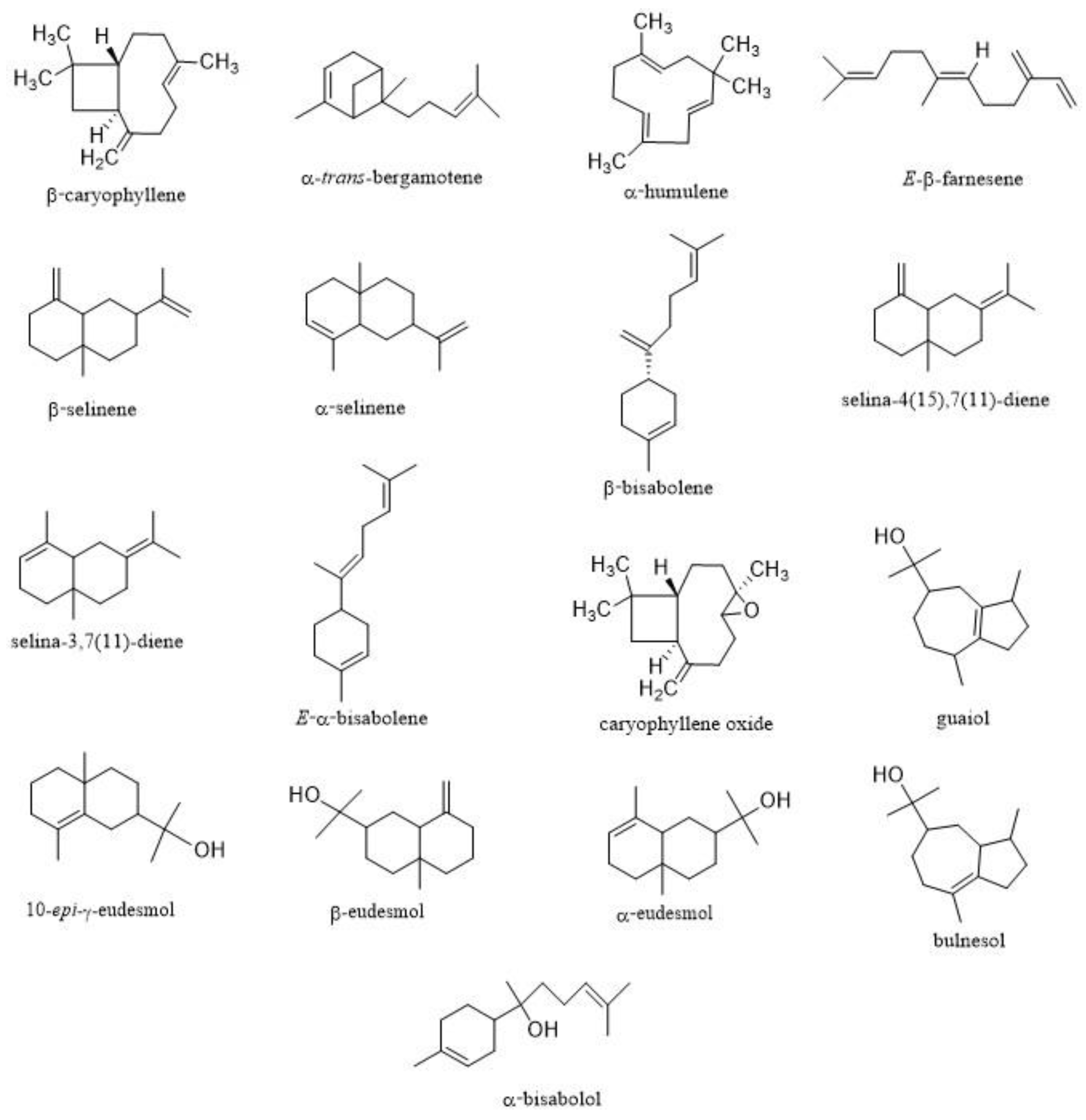
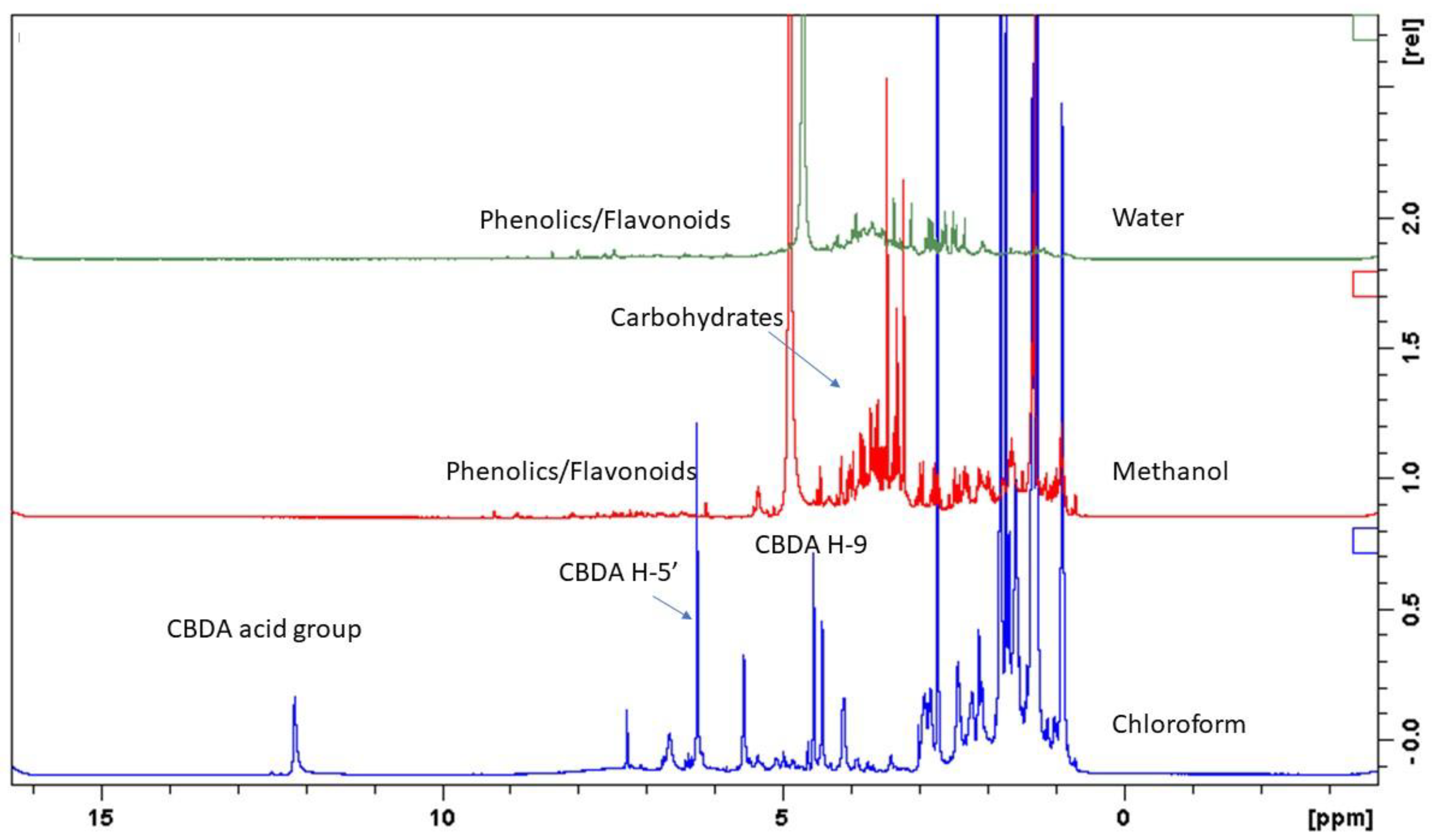
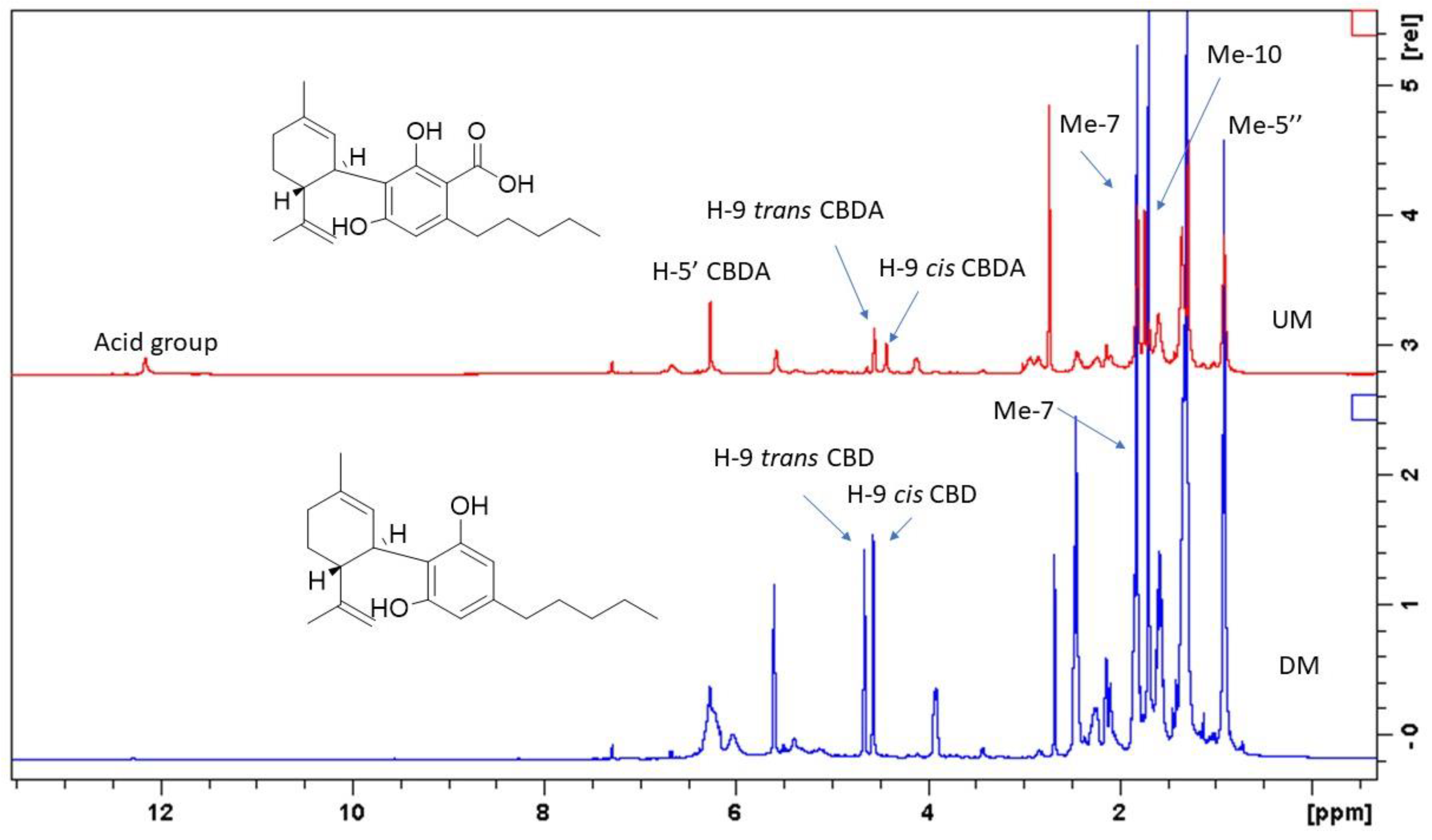
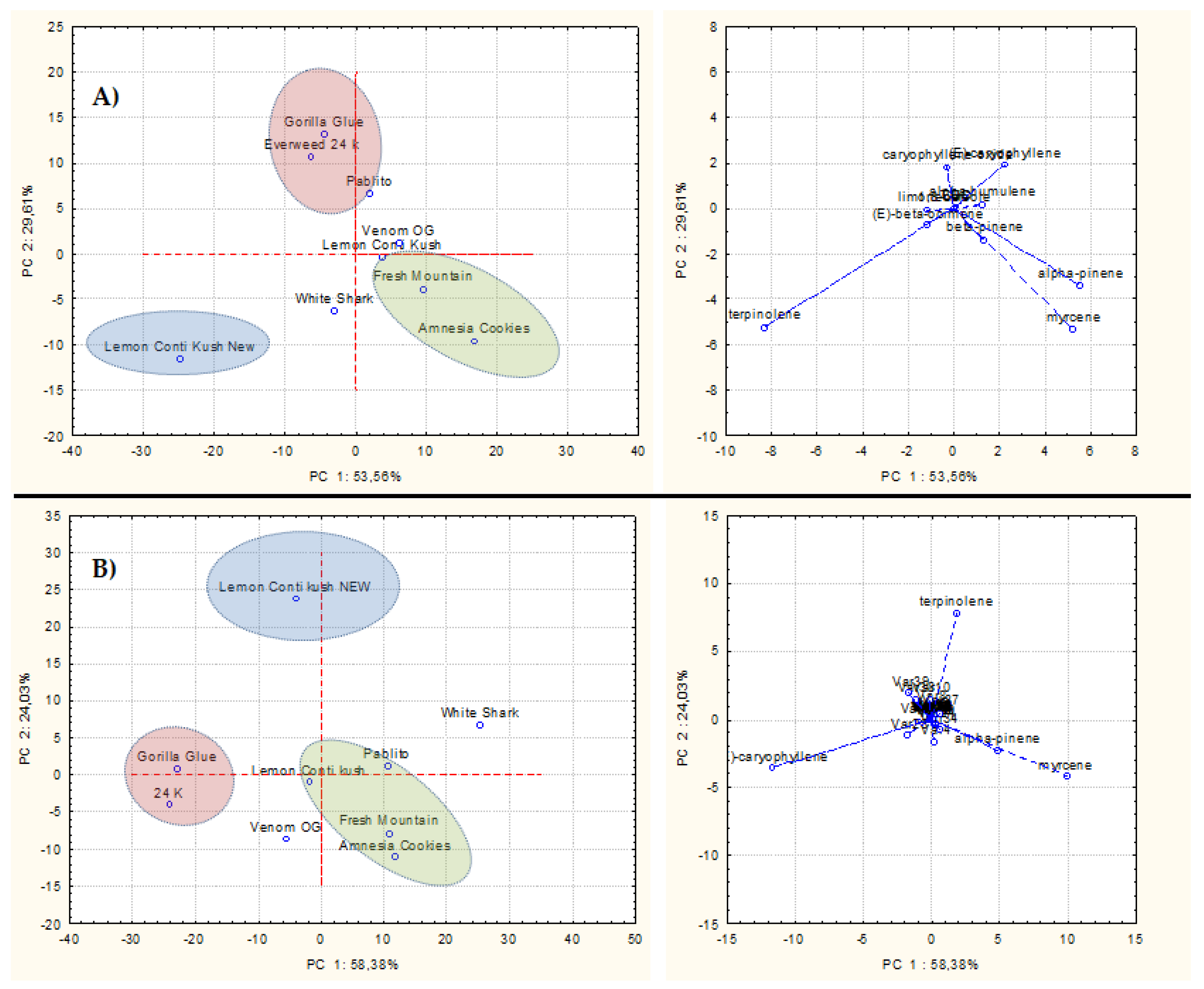
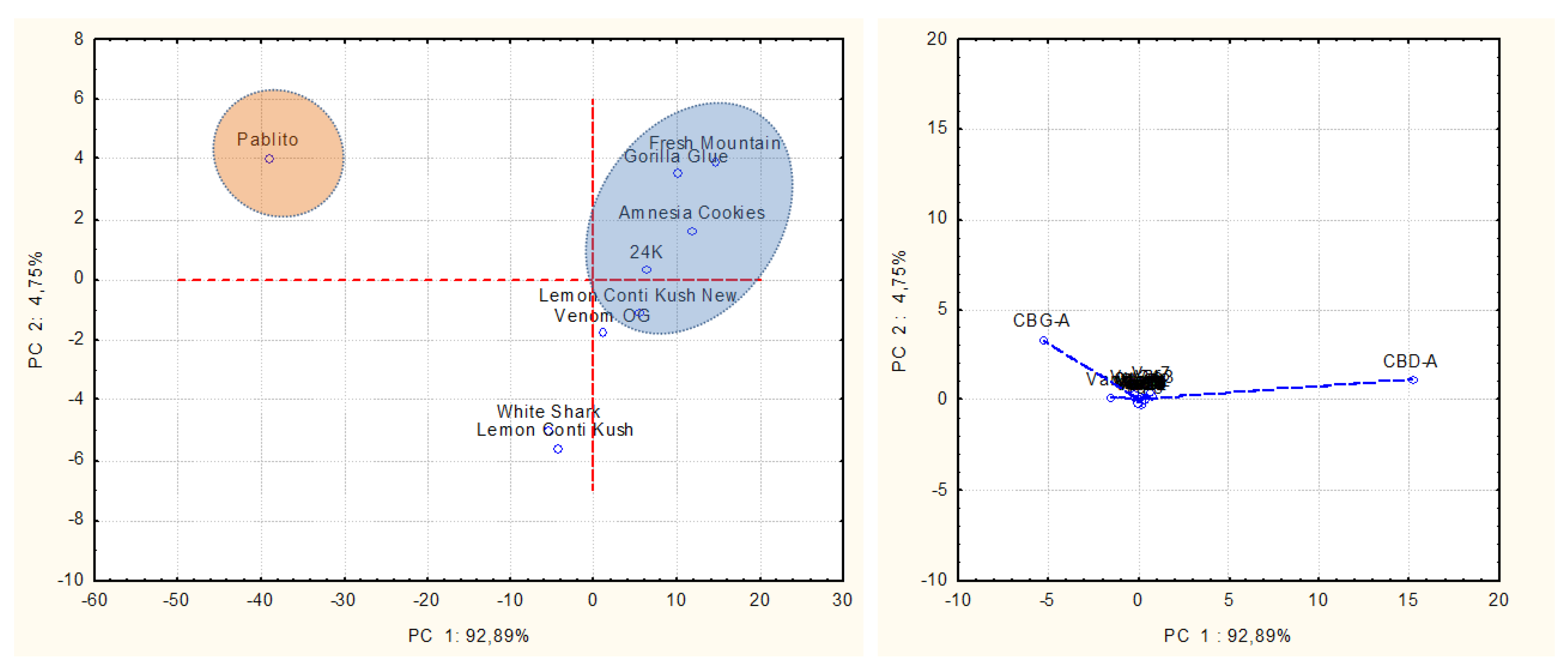
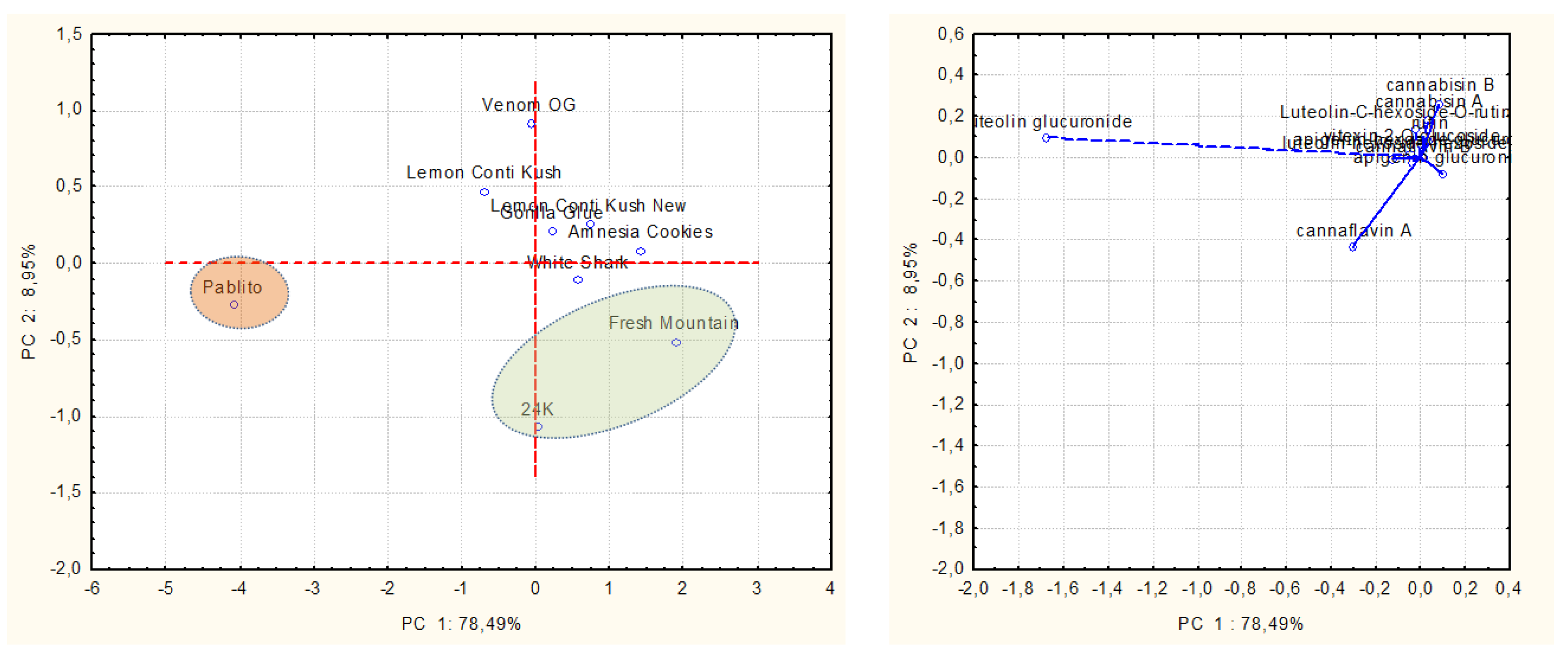
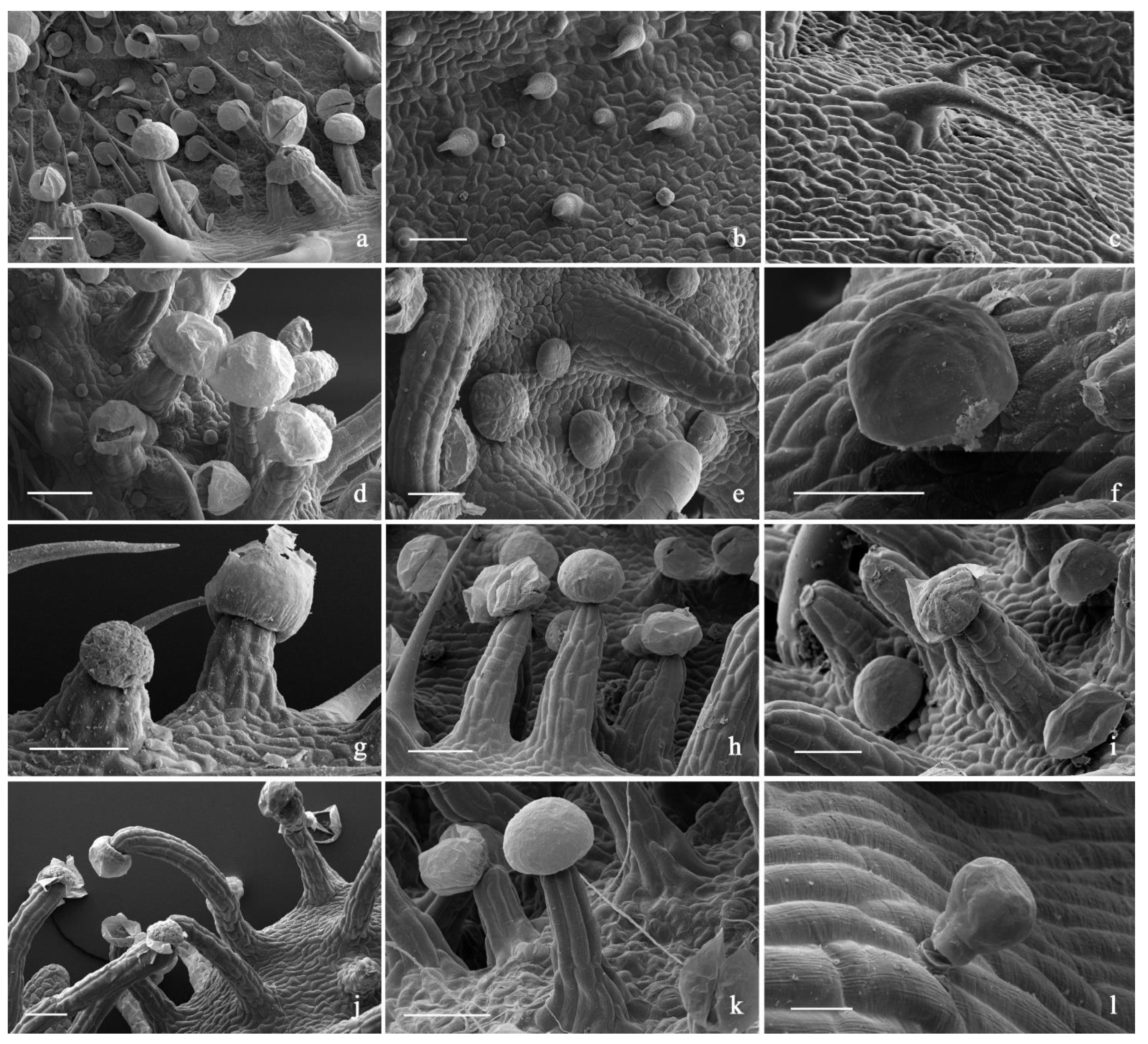
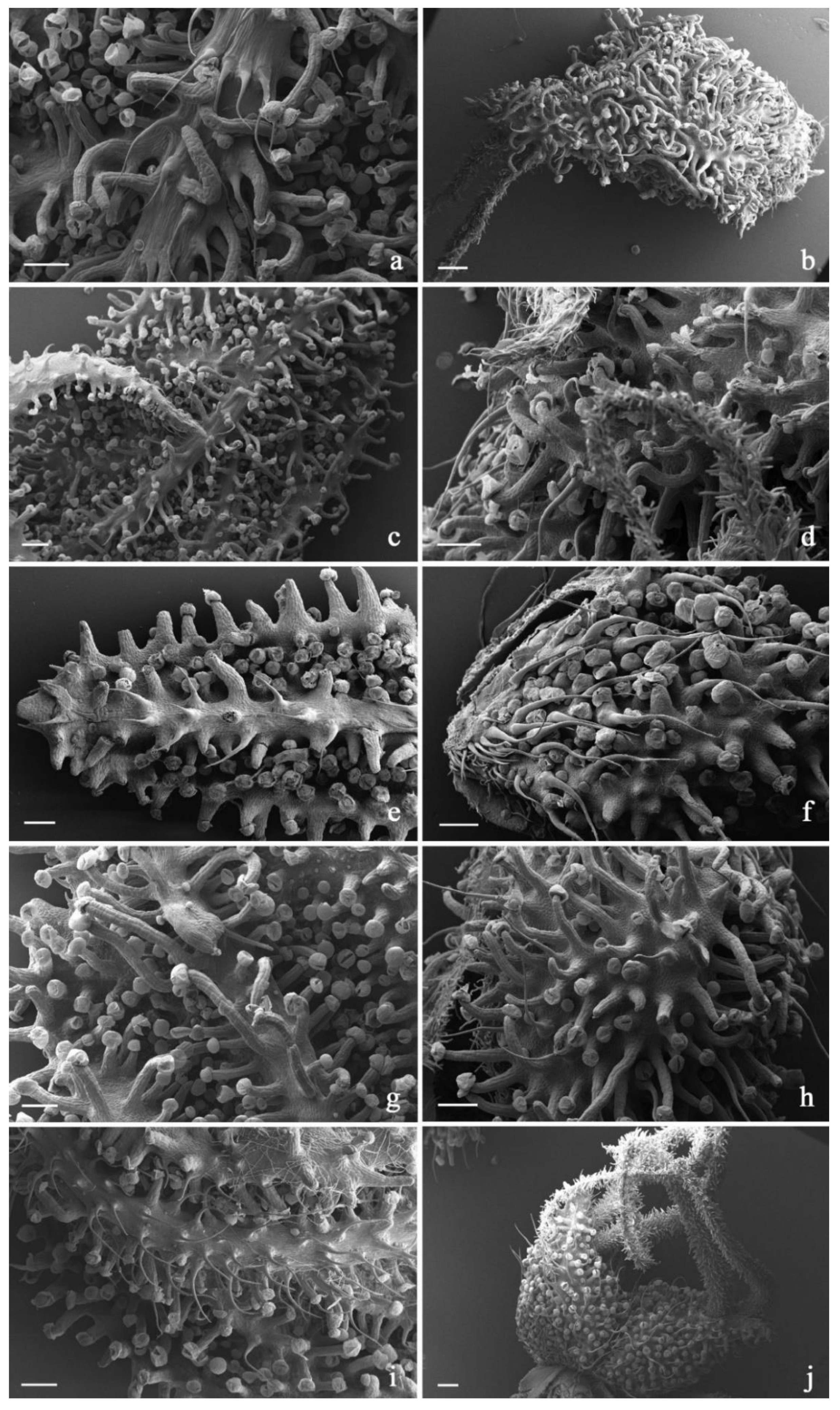
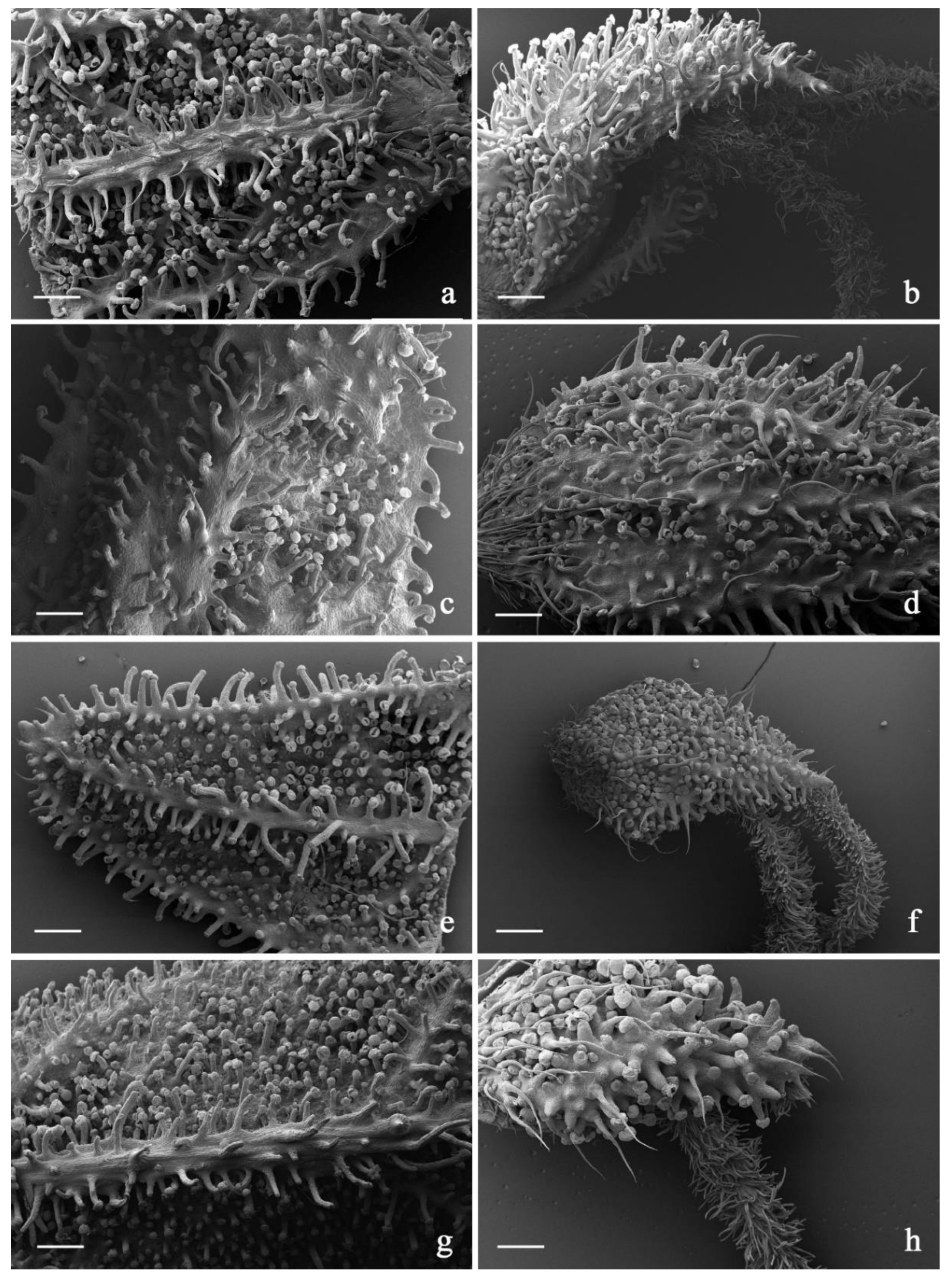

| Compound | Hemp Variety | ||||||||
|---|---|---|---|---|---|---|---|---|---|
| White Shark | Lemon Conti Kush New | Lemon Conti Kush | Venom OG | Pablito | 24 K | Fresh Mountain | Amnesia Cookies | Gorilla Glue | |
| (g/100 g) | |||||||||
| α-pinene | 8.53 | 3.24 | 11.48 | 21.19 | 8.35 | 0.73 | 9.32 | 21.16 | 0.74 |
| β-pinene | 3.59 | 2.78 | 4.67 | 4.79 | 3.21 | 0.68 | 3.66 | 7.45 | 0.82 |
| myrcene | 20.28 | 11.14 | 17.13 | 10.57 | 12.56 | 8.12 | 27.46 | 29.23 | 7.16 |
| limonene | 9.17 | 5.97 | 3.38 | 4.28 | 3.30 | 4.18 | 4.10 | 2.20 | 6.79 |
| 1,8-cineole | 0.07 | 0.13 | 0.04 | 0.07 | 0.03 | 0.02 | 0.04 | 0.04 | 0.02 |
| (E)-β-ocimene | 0.10 | 4.51 | 0.16 | 0.05 | 0.06 | 0.03 | 0.02 | 0.02 | 0.03 |
| terpinolene | 9.51 | 30.47 | 1.33 | 1.65 | 0.52 | 3.69 | 0.25 | 0.18 | 0.27 |
| (E)-caryophyllene | 10.79 | 10.40 | 11.91 | 17.19 | 18.15 | 18.12 | 19.70 | 18.91 | 18.94 |
| humulene | 2.96 | 3.04 | 4.46 | 4.64 | 6.82 | 5.35 | 5.51 | 8.57 | 4.86 |
| caryophyllene oxide | 3.52 | 3.34 | 3.88 | 5.60 | 7.97 | 8.00 | 1.28 | 3.93 | 6.62 |
| CBD | 5.54 | 2.91 | 4.26 | 5.25 | 3.13 | 4.02 | 3.86 | 2.30 | 3.06 |
| Δ-9-THC | 0.13 | 0.09 | 0.10 | 0.13 | 0.12 | 0.12 | 0.12 | 0.20 | 0.20 |
| Yields (%) | 0.64 | 1.51 | 1.03 | 0.86 | 0.49 | 1.08 | 1.23 | 1.81 | 1.33 |
| Variety | |||||||||||||||
|---|---|---|---|---|---|---|---|---|---|---|---|---|---|---|---|
| Pablito | White Shark | Gorilla Glue | 24 K | Fresh Mountain | Venom OG | Lemon Conti Kush | Lemon Conti Kush New | Amnesia Cookies | |||||||
| N | Component a | RI b HP-5MS | RI c lit. apol. | RI d DB-WAX | RI e lit. polar | % HP-5MS | ID f | ||||||||
| 1 | heptanal | 901 | 901 | 1187 | 1184 | 0.9 | 0.3 | 0.2 | 0.2 | 0.2 | 0.3 | 0.6 | 0.1 | tr g | RI,MS |
| 2 | α-thujene | 926 | 924 | 1028 | 1025 | 0.1 | 0.2 | tr | 0.3 | tr | RI,MS | ||||
| 3 | α-pinene | 932 | 933 | 1026 | 1027 | 9.0 | 11.3 | 0.7 | 0.2 | 11.0 | 23.3 | 12.5 | 3.5 | 24.6 | Std |
| 4 | camphene | 947 | 946 | 1071 | 1063 | 0.1 | 0.3 | 0.1 | 0.2 | 0.2 | 0.4 | 0.2 | 0.1 | 0.3 | Std |
| 5 | β-pinene | 975 | 974 | 1114 | 1112 | 3.0 | 4.2 | 0.7 | 0.2 | 4.0 | 5.0 | 4.8 | 2.7 | 8.2 | Std |
| 6 | myrcene | 990 | 988 | 1164 | 1165 | 10.7 | 21.5 | 6.6 | 0.2 | 26.0 | 9.7 | 14.9 | 9.5 | 27.1 | Std |
| 7 | α-phellandrene | 1004 | 1002 | 1169 | 1167 | tr | 0.5 | tr | tr | tr | 1.3 | tr | Std | ||
| 8 | δ-3-carene | 1009 | 1008 | 1153 | 1152 | 0.4 | tr | 1.0 | Std | ||||||
| 9 | α-terpinene | 1016 | 1014 | 1184 | 1193 | tr | 0.4 | 0.1 | tr | tr | tr | 1.3 | tr | Std | |
| 10 | limonene | 1027 | 1024 | 1203 | 1193 | 2.7 | 10.2 | 6.8 | 4.6 | 3.9 | 3.9 | 2.8 | 5.4 | 1.8 | Std |
| 11 | 1,8-cineole | 1030 | 1026 | 1217 | 1212 | 0.1 | tr | 1.5 | tr | 0.1 | 0.2 | Std | |||
| 12 | (Z)-β-ocimene | 1038 | 1032 | tr | tr | tr | Std | ||||||||
| 13 | (E)-β-ocimene | 1048 | 1044 | 1253 | 1252 | tr | tr | tr | 4.0 | Std | |||||
| 14 | γ-terpinene | 1058 | 1054 | 1250 | 1257 | tr | 0.3 | tr | 0.3 | tr | 0.1 | 1.0 | tr | Std | |
| 15 | terpinolene | 1087 | 1086 | 1288 | 1282 | 0.3 | 11.8 | 0.3 | 0.4 | 0.2 | 0.1 | 1.0 | 30.2 | 0.1 | RI,MS |
| 16 | linalool | 1099 | 1095 | 1547 | 1549 | 0.2 | 1.0 | 0.9 | 2.9 | 0.1 | 1.0 | 0.4 | 0.4 | tr | Std |
| 17 | endo-fenchol | 1112 | 1114 | 1589 | 1582 | 0.2 | 0.8 | 1.7 | 1.0 | 0.8 | 0.7 | 0.6 | 0.4 | tr | RI,MS |
| 18 | trans-pinene hydrate | 1120 | 1119 | 0.1 | 0.5 | 1.1 | 0.6 | 0.5 | 0.4 | 0.4 | 0.3 | tr | RI,MS | ||
| 19 | borneol | 1164 | 1165 | 1711 | 1701 | 0.1 | 0.2 | 0.4 | 0.3 | 0.2 | 0.3 | 0.2 | 0.1 | tr | Std |
| 20 | α-terpineol | 1189 | 1186 | 1703 | 1698 | 0.3 | 1.0 | 1.4 | 1.3 | 0.6 | 0.7 | 0.4 | 1.0 | 0.1 | Std |
| 21 | hexyl isobutanoate | 1192 | 1191 | 0.1 | tr | 0.3 | RI,MS | ||||||||
| 22 | sativene | 1393 | 1390 | 0.1 | tr | 0.1 | tr | RI,MS | |||||||
| 23 | α-cis-bergamotene | 1416 | 1411 | 1577 | 1577 | 0.1 | 0.1 | 0.2 | tr | 0.1 | 0.1 | RI,MS | |||
| 24 | (E)-caryophyllene | 1420 | 1417 | 1612 | 1612 | 15.5 | 11.4 | 17.6 | 19.9 | 16.0 | 17.1 | 10.7 | 8.2 | 15.3 | Std |
| 25 | α-trans-bergamotene | 1436 | 1432 | 1594 | 1583 | 0.2 | 1.0 | 1.3 | 1.4 | 0.4 | 0.7 | 0.9 | 0.1 | 0.1 | RI,MS |
| 26 | α-guaiene | 1439 | 1439 | tr | 2.8 | RI,MS | |||||||||
| 27 | α-humulene | 1455 | 1452 | 1685 | 1667 | 6.5 | 3.0 | 4.7 | 6.3 | 4.7 | 4.9 | 4.1 | 2.4 | 7.6 | Std |
| 28 | (E)-β-farnesene | 1457 | 1454 | 1668 | 1674 | 0.1 | 1.1 | 1.2 | 1.5 | 0.2 | 0.6 | 0.8 | 0.1 | tr | Std |
| 29 | allo-aromadendrene | 1462 | 1458 | 0.1 | tr | 0.2 | tr | tr | 0.2 | tr | tr | RI,MS | |||
| 30 | γ-muurolene | 1478 | 1478 | 0.1 | 0.1 | 0.1 | RI,MS | ||||||||
| 31 | γ-curcumene | 1480 | 1481 | 0.1 | tr | RI,MS | |||||||||
| 32 | β-selinene | 1487 | 1489 | 1736 | 1734 | 0.8 | 0.2 | 0.2 | 0.6 | 0.1 | 0.5 | 0.6 | 1.3 | RI,MS | |
| 33 | valencene | 1494 | 1496 | 0.2 | 0.4 | 0.1 | 0.1 | RI,MS | |||||||
| 34 | α-selinene | 1496 | 1498 | 1740 | 1737 | 0.7 | 0.2 | 0.5 | 0.1 | 0.8 | 0.1 | 0.8 | 0.7 | 1.1 | RI,MS |
| 35 | β-dihydro-agarofuran | 1501 | 1503 | 0.1 | tr | 0.1 | 0.1 | 0.1 | tr | tr | tr | RI,MS | |||
| 36 | α-bulnesene | 1507 | 1509 | 0.1 | 6.3 | RI,MS | |||||||||
| 37 | β-bisabolene | 1509 | 1505 | 1734 | 1727 | 0.7 | 0.1 | 1.4 | 1.9 | 1.1 | 0.1 | 1.6 | 0.6 | 0.1 | RI,MS |
| 38 | β-curcumene | 1512 | 1514 | 0.1 | 0.2 | 0.2 | tr | 0.1 | RI,MS | ||||||
| 39 | sesquicineole | 1515 | 1515 | tr | 0.1 | 0.1 | 0.5 | 0.1 | 0.2 | 0.3 | tr | RI,MS | |||
| 40 | zonarene | 1522 | 1528 | 0.1 | tr | 0.9 | 0.3 | tr | RI,MS | ||||||
| 41 | selina-4(15),7(11)-diene | 1536 | 1544 | 0.3 | 0.1 | 7.1 | 3.5 | 0.1 | 5.0 | 3.4 | 0.1 | RI,MS | |||
| 42 | selina-3,7(11)-diene | 1543 | 1538 | 1796 | 1791 | 0.3 | 12.5 | 7.8 | 0.3 | 8.7 | 6.4 | 0.7 | RI,MS | ||
| 43 | (E)-α-bisabolene | 1543 | 1544 | 1780 | 1784 | 1.7 | 1.8 | RI,MS | |||||||
| 44 | caryophyllene oxide | 1584 | 1582 | 2008 | 2005 | 0.8 | 0.2 | 0.2 | 0.5 | 0.6 | 1.0 | 0.4 | 0.1 | 0.1 | Std |
| 45 | guaiol | 1598 | 1600 | 2100 | 2103 | 7.5 | 3.0 | 5.8 | 9.7 | tr | 5.9 | 3.3 | 2.1 | 2.1 | RI,MS |
| 46 | eudesmol-5-epi-7-epi-α | 1606 | 1607 | 0.4 | 0.1 | 0.2 | 0.4 | 0.2 | 0.1 | 0.1 | tr | RI,MS | |||
| 47 | 10-epi-γ-eudesmol | 1621 | 1622 | 2124 | 2137 | 7.6 | 4.1 | 7.0 | 10.2 | tr | 6.5 | 4.6 | 3.1 | 3.0 | RI,MS |
| 48 | γ-eudesmol | 1633 | 1630 | 1.7 | 0.5 | 0.8 | 1.5 | 1.0 | 0.5 | 0.3 | 0.3 | RI,MS | |||
| 49 | β-eudesmol | 1651 | 1649 | 3.1 | 1.3 | 1.8 | 3.4 | tr | 2.3 | 1.1 | 0.7 | 0.7 | RI,MS | ||
| 50 | α-eudesmol | 1654 | 1652 | 4.3 | 2.0 | 2.8 | 4.7 | 0.2 | 3.2 | 1.7 | 1.1 | 1.1 | RI,MS | ||
| 51 | eudesmol-7-epi-α | 1659 | 1658 | 0.8 | 0.3 | 0.5 | 0.9 | 0.6 | 0.3 | 0.1 | 0.1 | RI,MS | |||
| 52 | bulnesol | 1668 | 1670 | 2201 | 2196 | 6.0 | 2.6 | 4.4 | 7.2 | 3.9 | 2.7 | 1.7 | 1.7 | RI,MS | |
| 53 | α-bisabolol | 1684 | 1685 | 2215 | 2219 | 8.6 | 0.2 | 2.7 | 8.4 | 4.3 | 0.5 | 5.2 | 1.9 | tr | Std |
| 54 | eudesm-7(11)-4-ol | 1697 | 1700 | tr | tr | 0.1 | tr | tr | 0.3 | 0.1 | RI,MS | ||||
| 55 | cannabidiol | 2427 | 2430 | 0.2 | 0.6 | 0.2 | 0.4 | 0.5 | 1.0 | 0.5 | 0.1 | 0.1 | Std | ||
| 56 | cannabichromene | 2434 | 2440 | tr | tr | tr | tr | tr | tr | tr | tr | tr | RI,MS | ||
| Total identified (%) | 96.07 | 97.51 | 96.13 | 95.42 | 98.13 | 96.63 | 93.80 | 96.47 | 98.42 | ||||||
| Variety | Enant. % | |||||
|---|---|---|---|---|---|---|
| α-Pinene (−):(+) | β-Pinene (+):(−) | Limonene (−):(+) | Linalool (−):(+) | (E)-Caryophyllene (+):(−) | Caryophyllene Oxide (+):(−) | |
| White Shark | 11.6:88.4 | 70.9:29.1 | 93.5:6.5 | 8.4:91.6 | 0:100 | 0:100 |
| Lemon Conti Kush | 4.9:95.1 | 78.4:21.6 | 92.4:7.6 | 6.9:93.1 | 0:100 | 0:100 |
| Lemon Conti Kush New | 3.2:96.8 | 66.4:33.6 | 91.4:8.6 | 34.8:65.2 | 0:100 | 0:100 |
| Pablito | 1.6:98.5 | 84.8:15.2 | 90.4:9.6 | 12.3:87.7 | 0:100 | 0:100 |
| Fresh Mountain | 7.8:92.2 | 74.6:25.4 | 93.0:7.0 | 0:100 | 0:100 | 0:100 |
| Amnesia Cookies | 2.9:97.1 | 88.6:11.4 | 74.1:25.9 | 28.2:71.8 | 0:100 | 0:100 |
| 24 K | 7.0:93.0 | 0:100 | 97.4:2.6 | 2.8:97.2 | 0:100 | 0:100 |
| Venom OG | 4.6:95.4 | 81.0:19.0 | 87.9:12.1 | 0:100 | 0:100 | 0:100 |
| Gorilla Glue | 7.9:92.1 | 0:100 | 97.4:2.6 | 0:100 | 0:100 | 0:100 |
| No | Compound | Variety | ||||||||
|---|---|---|---|---|---|---|---|---|---|---|
| Lemon Conti Kush | Fresh Mountain | 24 K | Gorilla Glue | White Shark | Venom OG | Lemon Conti Kush New | Amnesia Cookies | Pablito | ||
| % | ||||||||||
| 1 | α-thujene | tr | 0.2 | |||||||
| 2 | α-pinene | 14.4 | 10.7 | 1.5 | 1.4 | 12.0 | 3.6 | 2.0 | 18.3 | 12.4 |
| 3 | camphene | 0.2 | 0.2 | tr | 0.1 | 0.2 | 0.4 | 0.2 | 0.2 | |
| 4 | β-pinene | 6.1 | 6.8 | 6.4 | ||||||
| 5 | myrcene | 21.3 | 39.2 | 18.3 | 15.0 | 44.6 | 31.8 | 15.9 | 37.2 | 35.2 |
| 6 | α-phellandrene | 0.6 | 0.9 | tr | 0.3 | |||||
| 7 | α-terpinene | 0.2 | ||||||||
| 8 | limonene | 3.8 | 3.8 | 6.2 | 8.3 | 11.0 | 8.2 | 5.4 | 1.8 | 5.9 |
| 9 | p-cymene | 0.1 | ||||||||
| 10 | (Z)-β-ocimene | 0.1 | 0.1 | 1.1 | 5.5 | 1.2 | ||||
| 11 | γ-terpinene | 0.3 | 0.4 | 0.2 | ||||||
| 12 | p-cymenene | 0.2 | ||||||||
| 13 | terpinolene | 1.7 | 1.0 | 5.2 | 2.7 | 17.1 | 1.3 | 24.1 | tr | 9.2 |
| 14 | cis-ocimenol | 0.2 | ||||||||
| 15 | copaene | 0.1 | ||||||||
| 16 | aristolene | 0.1 | ||||||||
| 17 | fenchol | 0.1 | 0.2 | 0.4 | 0.1 | |||||
| 18 | butanoic acid, hexyl ester | 0.2 | ||||||||
| 19 | α-terpineol | 0.3 | 0.1 | 0.5 | 0.6 | 0.4 | 0.3 | 0.4 | ||
| 20 | ylangene | 0.3 | 0.1 | |||||||
| 21 | α-santalene | 0.2 | 0.3 | 0.4 | tr | 0.1 | ||||
| 22 | trans-α-bergamotene | 0.9 | 0.4 | |||||||
| 23 | β-caryophyllene | 25.7 | 23.1 | 50.3 | 43.8 | 10.9 | 36.5 | 22.8 | 23.0 | 21.8 |
| 24 | α-guaiene | 3.6 | 0.4 | |||||||
| 25 | α-himachalene | 2.3 | 1.7 | |||||||
| 26 | (E)-β-farnesene | 0.2 | 0.4 | |||||||
| 27 | β-bisabolene | 3.2 | 2.2 | |||||||
| 28 | α-humulene | 7.1 | 5.1 | 10.6 | 7.4 | 1.9 | 8.0 | 5.6 | 9.0 | 6.5 |
| 29 | aromadendrene | 0.3 | 0.2 | |||||||
| 30 | β-eudesmene | 0.6 | 0.7 | 0.2 | 1.3 | 0.7 | ||||
| 31 | α-farnesene | 0.1 | 0.1 | 0.5 | 0.6 | |||||
| 32 | δ-selinene | 0.4 | 0.4 | |||||||
| 33 | valencene | 0.4 | ||||||||
| 34 | δ-guaiene | 5.8 | 0.7 | 1.1 | ||||||
| 35 | β-sesquiphellandrene | 0.1 | ||||||||
| 36 | δ-cadinene | 0.1 | ||||||||
| 37 | trans-α-bisabolene | 1.9 | 1.6 | 2.1 | 0.3 | 2.4 | 0.6 | 1.1 | ||
| 38 | selina-4(15),7-(11)-diene | 5.1 | 0.3 | 6.3 | 5.2 | 1.8 | ||||
| 39 | selina-3,7(11)-diene | 7.6 | 3.0 | 10.0 | 0.1 | 0.3 | 7.9 | 0.3 | 2.6 | |
| 40 | guaia-3,9-diene | 0.4 | ||||||||
| Total identified (%) | 99.7 | 100.0 | 99.9 | 100.0 | 99.8 | 99.8 | 99.8 | 99.7 | 100.0 |
| Variety | TPC (mg GAE/g DE) | TFC (mg RE/g DE) | DPPH (mg TE/g DE) |
|---|---|---|---|
| Lemon Conti Kush New | 72.18 | 46.30 | 142.33 |
| Lemon Conti Kush | 54.74 | 30.00 | 111.89 |
| Pablito | 66.28 | 41.63 | 135.33 |
| Fresh Mountain | 40.38 | 18.15 | 90.33 |
| 24 K | 65.00 | 40.37 | 138.11 |
| Venom OG | 69.62 | 42.96 | 143.00 |
| Amnesia Cookies | 57.82 | 25.56 | 109.67 |
| White Shark | 62.69 | 30.78 | 115.89 |
| Gorilla Glue | 57.56 | 31.48 | 120.78 |
| Variety | TPC (mg GAE/g DW) | TFC (mg RE/g DW) | DPPH (mg TE/g DW) |
|---|---|---|---|
| Lemon Conti Kush | 15.51 | 12.58 | 25.07 |
| Pablito | 16.31 | 13.58 | 36.84 |
| Fresh Mountain | 16.13 | 10.33 | 24.11 |
| 24 K | 23.00 | 22.00 | 39.07 |
| Venom OG | 23.90 | 20.08 | 41.67 |
| Amnesia Cookies | 15.82 | 8.33 | 26.62 |
| White Shark | 18.10 | 13.58 | 34.40 |
| Gorilla Glue | 20.28 | 16.92 | 38.62 |
| Carmagnola CS | 9.54 | 3.25 | 13.04 |
| Santhica | 12.36 | 4.33 | 10.22 |
| Kompolti | 15.10 | 6.50 | 15.56 |
| Compound | Variety | |||||||||||||||||
|---|---|---|---|---|---|---|---|---|---|---|---|---|---|---|---|---|---|---|
| White Shark | 24 K | Lemon Conti Kush | Lemon Conti Kush New | Pablito | Venom OG | Gorilla Glue | Fresh Mountain | Amnesia Cookies | ||||||||||
| UM | DM | UM | DM | UM | DM | UM | DM | UM | DM | UM | DM | UM | DM | UM | DM | UM | DM | |
| mg/g | ||||||||||||||||||
| cannabisin A | 0.18 | 0.02 | 0.07 | 0.02 | 0.25 | 0.03 | 0.58 | 0.06 | 0.01 | 0.57 | 0.02 | 0.86 | 0.12 | 0.03 | 0.01 | 0.05 | 0.08 | |
| cannabisin B | 0.38 | 0.12 | 0.05 | 0.05 | 0.12 | 0.14 | 1.35 | 0.23 | 0.02 | 0.82 | 0.08 | 0.81 | 0.13 | 0.02 | 0.004 | 0.54 | 0.12 | |
| luteolin-C-hexoside-O-rutinoside | 0.72 | 0.05 | 0.05 | 0.05 | 0.16 | 0.03 | 0.63 | 0.03 | 0.50 | 0.03 | 0.66 | 0.12 | 0.51 | 0.02 | 0.18 | 0.38 | 0.06 | |
| rutin | 0.53 | 0.04 | 0.30 | 0.02 | 0.33 | 0.03 | 0.33 | 0.06 | 0.07 | 0.11 | 0.51 | 0.03 | 0.27 | 0.04 | 0.03 | 0.03 | 0.21 | 0.03 |
| luteolin-hexoside-hexoside | 0.16 | 0.04 | 0.12 | 0.04 | 0.13 | 0.02 | 0.06 | 0.03 | 0.50 | 0.02 | 0.15 | 0.06 | 0.04 | 0.02 | 0.01 | 0.18 | 0.06 | |
| vitexin 2″-O-glucoside | 0.12 | 0.03 | 0.12 | 0.05 | 0.09 | 0.02 | 0.17 | 0.04 | 0.30 | 0.07 | 0.29 | 0.03 | 0.15 | 0.02 | 0.17 | 0.04 | 0.05 | 0.03 |
| apigenin-hexoside-glucuronide | 0.20 | 0.06 | 0.15 | 0.03 | 0.17 | 0.54 | 0.06 | 0.02 | 0.12 | 0.03 | 0.18 | 0.03 | 0.13 | 0.46 | 0.16 | 0.04 | 0.13 | 0.02 |
| luteolin 7-glucuronide | 2.77 | 0.56 | 3.11 | 0.69 | 4.18 | 0.12 | 2.58 | 0.99 | 7.26 | 1.49 | 3.52 | 0.30 | 3.10 | 0.12 | 1.43 | 0.29 | 2.00 | 0.30 |
| apigenin 7-glucuronide | 0.94 | 0.27 | 0.46 | 0.13 | 0.67 | 0.07 | 0.23 | 0.20 | 0.21 | 0.37 | 0.02 | 0.15 | 0.37 | 0.07 | 0.48 | 0.13 | 0.63 | 0.14 |
| cannflavin B | 0.89 | 0.88 | 0.72 | 0.75 | 0.67 | 0.43 | 0.36 | 0.9 | 0.51 | 0.56 | 0.58 | 0.42 | 0.33 | 0.25 | 0.34 | 0.51 | 0.35 | 0.43 |
| cannflavin A | 1.13 | 1.38 | 2.08 | 2.66 | 0.38 | 1.92 | 1.46 | 2.43 | 2.15 | 2.87 | 0.53 | 0.74 | 1.35 | 1.41 | 0.97 | 1.3 | 0.68 | 0.16 |
| Compound | Variety | ||||||||
|---|---|---|---|---|---|---|---|---|---|
| White Shark | 24 K | Lemon Conti Kush | Lemon Conti Kush New | Pablito | Venom OG | Gorilla Glue | Fresh Mountain | Amnesia Cookies | |
| (mg/g) | |||||||||
| cannabisin A | 0.33 | 0.39 | 0.22 | 0.30 | 0.57 | 0.11 | 0.33 | 0.33 | 0.12 |
| cannabisin B | 0.71 | 2.57 | 2.37 | 0.35 | 3.03 | 3.57 | 0.30 | 0.22 | 0.18 |
| luteolin-C-hexoside-O-rutinoside | 0.23 | 1.18 | 0.51 | 0.50 | 1.48 | 1.39 | 2.51 | 0.22 | 0.32 |
| rutin | 7.93 | 7.93 | 8.79 | 0.35 | 5.63 | 12.18 | 0.75 | 0.30 | 0.58 |
| luteolin-hexoside-hexoside | 0.21 | 0.20 | 0.49 | 2.35 | 0.21 | 0.34 | 0.21 | 0.38 | 0.21 |
| vitexin 2″-O-glucoside | 0.29 | 3.19 | 3.48 | 0.63 | 0.55 | 5.01 | 0.40 | 0.57 | 0.37 |
| apigenin-hexoside-glucuronide | 1.12 | 0.79 | 1.43 | 0.32 | 1.84 | 1.21 | 0.79 | 0.46 | 0.32 |
| luteolin 7-glucuronide | 0.05 | 0.30 | 0.20 | 0.27 | 0.22 | 0.05 | 0.29 | 0.34 | 0.22 |
| apigenin 7-glucuronide | 0.22 | 0.07 | 0.04 | 0.27 | 0.23 | 0.22 | 0.31 | 0.23 | 0.08 |
| cannflavin B | 0.05 | 0.04 | 0.08 | 0.23 | 0.09 | 0.16 | 0.12 | 0.06 | 0.20 |
| cannflavin A | 0.24 | 0.19 | 0.15 | 0.27 | 0.12 | 0.20 | 0.62 | 0.20 | 0.24 |
| Compound | Variety | |||||||||||||||||
|---|---|---|---|---|---|---|---|---|---|---|---|---|---|---|---|---|---|---|
| White Shark | 24 K | Lemon Conti Kush | Lemon Conti Kush New | Pablito | Venom OG | Gorilla Glue | Fresh Mountain | Amnesia Cookies | ||||||||||
| UM | DM | UM | DM | UM | DM | UM | DM | UM | DM | UM | DM | UM | DM | UM | DM | UM | DM | |
| mg/g | ||||||||||||||||||
| CBDA | 46.12 | 0.68 | 59.07 | 2.34 | 46.92 | 1.22 | 62.45 | 2.95 | 20.68 | 0.35 | 53.70 | 1.45 | 63.52 | 2.61 | 67.77 | 2.44 | 64.14 | 2.40 |
| CBD | 0.35 | 1.56 | 0.74 | 2.89 | 0.43 | 2.38 | 0.72 | 3.71 | 0.16 | 0.61 | 0.56 | 3.25 | 0.94 | 3.93 | 1.10 | 4.58 | 0.77 | 4.04 |
| CBGA | 2.11 | 0.46 | 3.07 | 0.43 | 0.99 | 0.41 | 0.54 | 0.32 | 23.50 | 0.50 | 3.25 | 0.41 | 4.91 | 0.45 | 3.26 | 0.42 | 2.24 | 0.43 |
| CBG | 0.13 | 0.16 | 0.28 | 0.12 | 0.11 | 0.82 | 0.26 | 2.57 | 0.14 | 0.58 | 0.17 | 0.93 | 0.05 | 0.48 | 0.14 | 0.85 | ||
| CBN | 0.44 | 1.13 | 0.35 | 0.11 | 0.38 | 0.13 | 0.04 | 0.14 | 0.08 | 0.33 | 0.07 | 0.08 | ||||||
| Δ-9-THC | 0.10 | 0.01 | 0.13 | 0.11 | 0.09 | 0.05 | 0.01 | 0.07 | 0.02 | 0.16 | 0.14 | 0.02 | 0.05 | |||||
| CBC | 0.46 | 0.05 | 0.34 | 0.27 | 0.25 | 0.15 | 0.56 | 0.13 | 0.65 | 0.01 | ||||||||
| Δ-9-THCA | 0.88 | 0.68 | 0.31 | 0.14 | 1.30 | 0.02 | 0.23 | 0.16 | 0.01 | 0.01 | 0.10 | 0.13 | 0.38 | |||||
| Plant Part | Trichome Morphotype | 24 K | Gorilla Glue | Lemon Conti Kush | Fresh Mountain | Amnesia Cookies | Pablito | White Shark | Venon OG | Lemon Conti Kush New |
|---|---|---|---|---|---|---|---|---|---|---|
| bract | hair-like lithocysts | ++ | ++ | + | ++ | ++ | + | ++ | ++ | + |
| bulbous | ++ | ++ | ++ | ++ | ++ | ++ | ++ | ++ | ++ | |
| capitate-stalked | ++ | ++ | ++ | ++ | ++ | ++ | ++ | ++ | ++ | |
| capitate sessile | + | + | + | + | + | + | + | + | + | |
| bracteole | hair-like lithocysts | ++ | ++ | + | ++ | ++ | + | ++ | + | + |
| bulbous | + | + | + | + | ++ | + | + | + | + | |
| capitate-stalked | ++ | ++ | ++ | ++ | ++ | ++ | ++ | ++ | ++ | |
| capitate sessile | ++ | + | ++ | + | ++ | ++ | + | ++ | ++ | |
| inflorescence axis | hair-like lithocysts | + | + | + | ++ | ++ | ++ | + | + | + |
| bulbous | + | + | + | ++ | ++ | ++ | + | ++ | + | |
| capitate-stalked | + | + | ++ | ++ | ++ | ++ | + | ++ | ++ | |
| capitate sessile | + | + | + | + | + | + | + | + | + |
Publisher’s Note: MDPI stays neutral with regard to jurisdictional claims in published maps and institutional affiliations. |
© 2022 by the authors. Licensee MDPI, Basel, Switzerland. This article is an open access article distributed under the terms and conditions of the Creative Commons Attribution (CC BY) license (https://creativecommons.org/licenses/by/4.0/).
Share and Cite
Mazzara, E.; Torresi, J.; Fico, G.; Papini, A.; Kulbaka, N.; Dall’Acqua, S.; Sut, S.; Garzoli, S.; Mustafa, A.M.; Cappellacci, L.; et al. A Comprehensive Phytochemical Analysis of Terpenes, Polyphenols and Cannabinoids, and Micromorphological Characterization of 9 Commercial Varieties of Cannabis sativa L. Plants 2022, 11, 891. https://doi.org/10.3390/plants11070891
Mazzara E, Torresi J, Fico G, Papini A, Kulbaka N, Dall’Acqua S, Sut S, Garzoli S, Mustafa AM, Cappellacci L, et al. A Comprehensive Phytochemical Analysis of Terpenes, Polyphenols and Cannabinoids, and Micromorphological Characterization of 9 Commercial Varieties of Cannabis sativa L. Plants. 2022; 11(7):891. https://doi.org/10.3390/plants11070891
Chicago/Turabian StyleMazzara, Eugenia, Jacopo Torresi, Gelsomina Fico, Alessio Papini, Nicola Kulbaka, Stefano Dall’Acqua, Stefania Sut, Stefania Garzoli, Ahmed M. Mustafa, Loredana Cappellacci, and et al. 2022. "A Comprehensive Phytochemical Analysis of Terpenes, Polyphenols and Cannabinoids, and Micromorphological Characterization of 9 Commercial Varieties of Cannabis sativa L." Plants 11, no. 7: 891. https://doi.org/10.3390/plants11070891
APA StyleMazzara, E., Torresi, J., Fico, G., Papini, A., Kulbaka, N., Dall’Acqua, S., Sut, S., Garzoli, S., Mustafa, A. M., Cappellacci, L., Fiorini, D., Maggi, F., Giuliani, C., & Petrelli, R. (2022). A Comprehensive Phytochemical Analysis of Terpenes, Polyphenols and Cannabinoids, and Micromorphological Characterization of 9 Commercial Varieties of Cannabis sativa L. Plants, 11(7), 891. https://doi.org/10.3390/plants11070891














